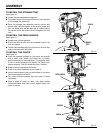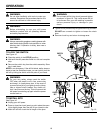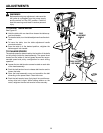
19
OPERATION
TO POSITION TABLE AND WORKPIECE
See Figures 17 and 18.
n Lock the table to the column in a position so that the tip
of the drill is just a little above the top of the workpiece.
n Always place a piece of backup material (wood,
plywood, etc.) on the table underneath the workpiece.
This will prevent “splintering” or making a heavy burr
on the underside on the workpiece as the drill breaks
through.
n To keep the backup material from spinning out of
control, it must contact the left side of the column, as
illustrated.
WARNING:
To prevent the workpiece or the backup material
from being torn from your hand while drilling,
position them against the left side of the column.
If the workpiece or the backup material are not
long enough to reach the column, clamp them
to the table. Failure to do this could result in
personal injury.
NOTE: For small pieces that cannot be clamped to the
table, use a drill press vise (not included).
WARNING:
The vise must be clamped or bolted to the table
to reduce the risk of injury from spinning work
and vise or tool breakage.
WARNING:
Check extension cords before each use. If
damaged, replace immediately. Never use
tool with a damaged cord since touching the
damaged area could cause electrical shock
resulting in serious injury.
TO MARK HOLE LOCATION
n Make a dent in the workpiece where you want the hole,
using a center punch or a sharp nail.
n Before turning the switch on, bring the drill down to the
workpiece lining it up with the hole location.
TO DRILL
n Pull down on the feed handles with only enough effort to
allow the drill to cut.
n Feeding too slowly might cause the drill to burn.
n Feeding too rapidly might stop the motor, cause the belt
or drill to slip, tear the workpiece loose or break the drill
bit.
Fig. 17
Fig. 18
®
®
WORKPIECE
BACKUP
MATERIAL
®
®
DRILL PRESS
VISE


















